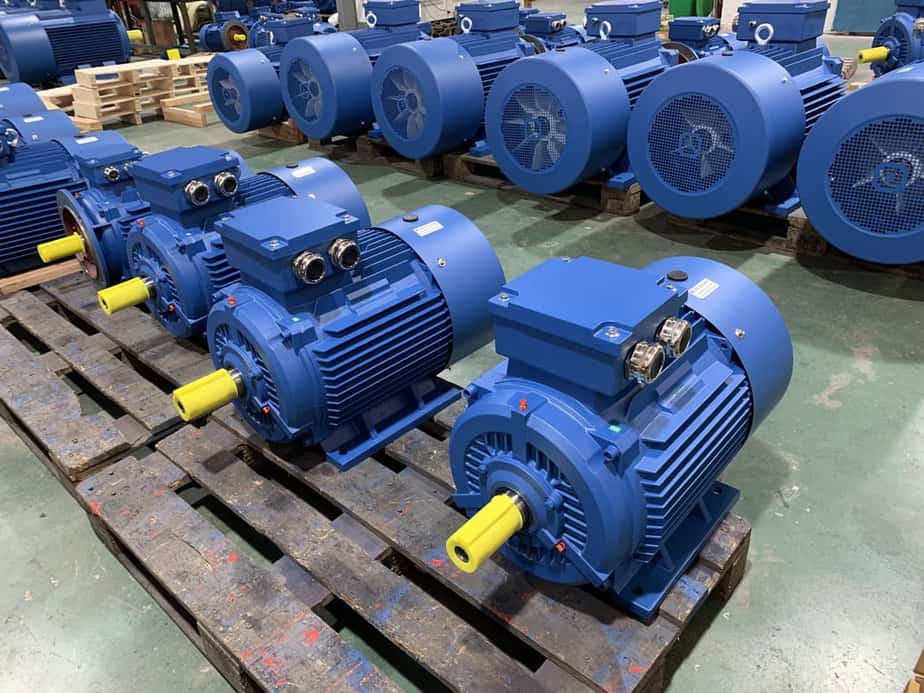ፋብሪካዎች ማሽኖቻቸውን ቀኑን ሙሉ በጥሩ ሁኔታ እንዲዋሹ እንዴት እንደሚጠብቁ ተገንዝበው ያውቃሉ? ደህና, ሁሉም ስለአሲ ሞተስ ነው.
ኤሲ ሞተርስ የኢንዱስትሪ ማሽኖች የጀርባ አቦይ ናቸው, ሁሉንም ነገር ከአስተዋወቂያ ቀበቶዎች ወደ ሮቦቲክ እጆች ናቸው.
ግን ለምን በጣም አስፈላጊ ናቸው, እና በትክክል የት ናቸው የሚጠቀሙት?
በአንዱ የኢንዱስትሪ ትግበራዎች ውስጥ, አንድ ዓይነት ኤሲ ሞተር1ጎልቶ ይታያል.
የ Squirrel የሽቦ የመግቢያ ሞተር በቀላል እና ዘላለማዊነት ምክንያት በኢንዱስትሪ ውስጥ በጣም በሰፊው ያገለገለው የሞተር ሞተር ሞተር ነው.እውነት
ቀጥተኛ ዲዛይን እና ጠንካራነት በብዙ የኢንዱስትሪ ትግበራዎች ውስጥ ተመራጭ ምርጫ ያድርጉት.
የ Squirrel የሽቦ የመግቢያ ሞተር በቀላል እና ዘላለማዊነት ምክንያት በኢንዱስትሪ ውስጥ በጣም በሰፊው ያገለገለው የሞተር ሞተር ሞተር ነው.
ወደ ይህ ሞተር በጣም ተወዳጅ የሆነው ለምን እንደሆነ በጥልቀት እንበልጠው. የጨርቃጨርቅ ፋብሪካን መጎብኘት እና በተመለከትኩበት ቦታ ሁሉ እነዚህ ሞተስ በስራ ላይ ነበሩ. የተጋለጡ ንድፍ ማለት ያለ ምንም ጊዜ ጥገና ሳይኖርባቸው አስቸጋሪ አከባቢዎችን ማስተናገድ ይችላሉ ማለት ነው.
የ Squirrel Case Doguion የሞተር ሞተር ለምን በጣም ተስፋፍቷል?
- ቀላልነትየሚያያዙት ገጾች መልዕክት በማይኖርበት ጊዜ, ለማቆየት ቀላል ናቸው.
- ጠንካራነት: ኃይለኛ የኢንዱስትሪ ሁኔታዎችን ለመቋቋም የተገነባ.
- ቅልጥፍና: በአፈፃፀም እና በኢነርጂ ፍጆታ መካከል ጥሩ ሚዛን ይሰጣል.
የት እንደሆነ ለማወቅ ትሞክራለህ የሲ ተከታታይ ሞተሮች2 ከስዕሉ ጋር ይስማማሉ.
የ AC ተከታታይ ሞተሮች በዋናነት ጥቅም ላይ የዋሉ በአስተማማኝ መተግበሪያ ውስጥ ጥቅም ላይ ይውላሉ, እንደ ኤሌክትሪክ ባቡር እና ክሬኖች.
ለመጀመሪያ ጊዜ ባየሁ ጊዜ የኤሌክትሪክ ባቡር 3ቅርብ, እነዚህ ሞተሮች እንደዚህ ያሉ ግዙፍ ማሽኖች እንዴት እንደሚወጡ ተገረምኩ.
የሲ ተከታታይ ሞተሮች ቁልፍ መተግበሪያዎች
- የኤሌክትሪክ ባቡሮች: ለማፋጠን አስፈላጊውን ፈሳሽ ያቅርቡ.
- ክራንች እና አስተናጋጆች: ከባድ ሸክሞችን በመጠቀም ከባድ ጭነት ይያዙ.
- የቤት ውስጥ መሣሪያዎች: በቫኪዩም ማጽጃዎች እና የኃይል መሣሪያዎች ውስጥ ይገኛል.
የ AC ሞተር እና የዲሲ ሞተር ትግበራዎች ምንድ ናቸው?
የ AC እና ዲሲ ሞተርስ ሚናዎችን መረዳቱ ትንሽ አስቸጋሪ ሊሆን ይችላል.
ኤሲ ሞተሮች በተለምዶ በቋሚ ፍጥነት ያገለግላሉ, ዲሲ ሞተሮች ለተለዋዋጭ ፍጥነት እና የመርከብ መቆጣጠሪያ ሁኔታዎች ተመራጭ ናቸው.
በአንድ ወቅት ለቺሊ, ከቺሊ ለሁለቱም ለማጓጓዣ ቀበቶዎች እና ልዩ ማሽን ሞተሮችን ያስፈለገው ከቺሊ ጀምሮ ደንበኛ, ክሊክተን ነበረኝ. የ DIC ሞተርስ ለባለበሱ ቁልፉ አነጋገሪ ቅልጥፍናዎች እንዴት እንደነበሩ ተወያይተናል, ዲሲ ሞተሮች ለጉምሩክ እንዲኖሩ የሚያስፈልጉትን ተለዋዋጭነት በሚሰጡበት ጊዜ ተወያይተናል.
የ AC እና ዲሲ የሞተር መተግበሪያዎች ማነፃፀር
| የሞተር ዓይነት | የተለመዱ ትግበራዎች | ጥቅሞች |
|---|---|---|
| ኤሲ ሞተር | ፓምፖች, አድናቂዎች, የመላኪያ ስርዓቶች | ዘላቂ, ዝቅተኛ ጥገና |
| ዲሲ ሞተር | የኤሌክትሪክ ተሽከርካሪዎች, ሮቦት | ትክክለኛ ፍጥነት እና የመርከብ መቆጣጠሪያ |
ዲሲ ሞተሮች በሁሉም ሁኔታዎች ከ AC ሞተሮች የበለጠ ውጤታማ ናቸው.ሐሰት
ውጤታማነት በማመልከቻው ላይ የተመሠረተ ነው, ምንም ዓይነት በአለም አቀፍ የበለጠ ውጤታማ አይደለም.
ኤሲ ሞተሮች ለቋሚ ፍጥነት መተግበሪያዎች ተስማሚ ናቸው.እውነት
ንድፍ ወጥነት ላላቸው የፍጥነት ተግባሮች ፍጹም ያደርጋቸዋል.
ስለዚህ, ምን ሚና በኤሲሲ ስርዓቶች ውስጥ የሞተር አጫዋች?
በኤሲሲ ስርዓቶች ውስጥ ሞተሮች ተለዋጭ የአሁኑን የኤሌክትሪክ ኃይል ወደ ሌሎች የኢንዱስትሪ ሥራዎች በሜካኒካዊ ኃይል ይለውጣሉ.
ወደ ሀ የምግብ ማቀነባበሪያ ተክል, አሲ ሞተርስ የማምረቻ መስመሮቹን ምን እንቆቅልሽ እንደነበር ተረድቼ, ምርቶችን በብቃት ማሸግ እንደነበረ አየሁ.
በኢንዱስትሪ ውስጥ የ AC ሞተስ ተግባራት
- የኃይል መለወጫየሚያያዙት ገጾች መልዕክት.
- የሂደት ቁጥጥርየሚያያዙት ገጾች መልዕክት.
- አውቶማቲክ: በዘመናዊ የኢንዱስትሪ መሣሪያዎች ውስጥ የላቀ ቁጥጥርን ማስገባት.
ማጠቃለያ
ኤሲ ሞተርስ ያልተለመዱ ጀግኖች ኃይል ኢንዱስትሪ, ዘመናዊው ዓለም እንዲኖር በማድረግ.
-
የ Squirrel የሽንት የግንባታ ሞተር ለምን ያህል በሰፊው ጥቅም ላይ እንደዋለ መረዳቱ ለኢንዱስትሪ የሞተር ምርጫ, በሞተር ሞተር ምርጫዎች ላይ ማስተዋልን በተመለከተ ግንባር ቀደም በመሆን እና ቀለል ባለ አከባቢዎች ላይ ወሳኝ ናቸው. ↩
-
ስለ የዚህ የሞተር ዓይነት ቀለል ያለ መረጃ ከአቅራቢያው ዲዛይን በስተጀርባ ያለውን ምክንያቶች ያብራራሉ, አንባቢዎች ይህ ባህርይ በኢንዱስትሪ ማመልከቻዎች ውስጥ ለምን አስፈላጊ እንደሆነ እንዲገነዘቡ ያስችላቸዋል ↩
-
በኤሌክትሪክ ባቡሮች ውስጥ ስለ አቢ ተከታዮች ልዩ ሚና ስለ ተለይተው ተማር እነዚህ ሞተሮች ለከባድ የትራንስፖርት ማመልከቻዎች የሚያስፈልገውን ኃይል በብቃት እንደሚሰጡ ግንዛቤ ይሰጣሉ ↩









